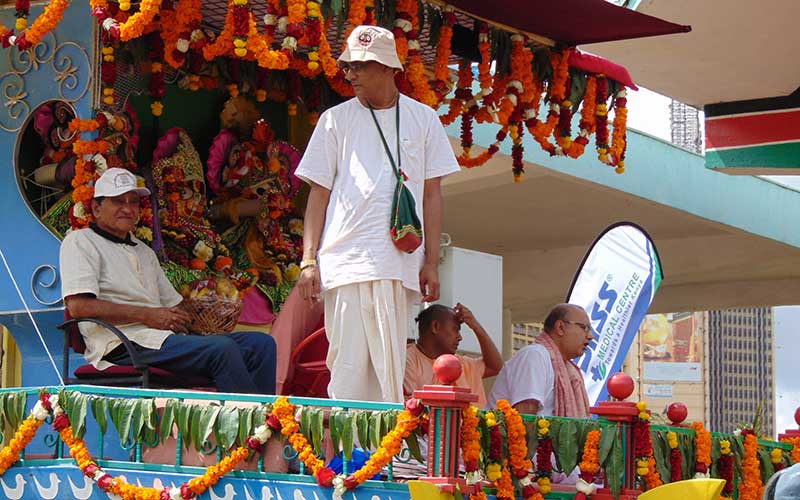
Madaraka Day may have passed, and Id-ul-Fitr to mark the end of Ramadan is here with us. But the other Saturday afternoon, if you were in Uhuru Park, Haile Selassie, Moi Avenue or the road leading up to Ngara and all the way to Parklands – depending on the hour – you may have come across an amazing sight.
A throng of thousands of people of Indian and African descsent chanting ‘Hare Krishna, Hare Krishna, Hare Hare, Hare Rama, Rama Rama, Hare Hare,’ as dozens of them pulled a huge chariot by rope through the city streets.
Seated on the chariot were dignitaries like the South African Swami as one of the ‘descendant’ representatives of His Divine Grace Bhaktivedanta Swami Prabhupada, diplomats like Indian High Commissioner Rahul Chhabra and distinguished guests like Navendra Raval – The Devki Group chairman worth Sh50 billion.
Mr. Raval was the Chief Guest for ‘Ratha-yatra,’ the Festival of the Chariots for practitioners of a spiritual culture known as Krishna Consciousness that has tens of thousands of adherents of all races in Nairobi alone.
Raval revels in religious festivals like Ratha-yatra because he himself came to Nairobi as a teenager in the 1960s as a Hindu priest’s apprentice to a temple in Kisumu.
Curious to find out more about this Krishna culture in the hidden heart of Kenya, I followed the big Ratha-yatra chariot on foot as it snaked its way through the city, followed by a convoy of Bliss Healthcare ambulance (just in case one of the chariot pullers were to collapse) as well as Soilex truck providing water to any of the dehydrated devotees of the Hare Krishna culture.
Many matatu drivers were going mad and hooting at the Chariot and convoy for slowing their progress, as the touts displayed their lout and loud matatu culture by swearing at them, but the curses were drowned out by the crowd’s great chants of the Hare Krishna maha-mantra.
Finally, at dusk, when we got to the Hare Krishna temple in the intersection of Ngara and Parklands, an old literary friend Tim Kimathi, turned Krishna monk, introduced me to one of their longer serving Nairobi monks Govinda Prem Dasa, to explain the Krishna culture to me.

“The mission of the International Society for Krishna Consciousness is to propagate the science of self-realisation through meditation, and to propagate the love of the monotheistic God that lies dormant in the heart of every living being.”
As such, Hare Krishnas are vegetarian, as well as teetotalers and against illicit sex in all its forms.
They also do not discriminate, unlike many other Hindu systems that have race or class castes – like Brahmins and Pariahs – and so limit access to their temples and to their religious culture.
“What you are calling our religious culture is actually a perfect science,” Monk Govinda Prem Dasa told me, his green eyes flashing with deep conviction. “Krishna Consciousness is taught to all without distinction of caste, colour, creed or gender, as enunciated by Lord Krishna himself in the classic Bhagavad-Gita scriptures.”
They also follow Vedic literatures – where hells, not hell, are actually places in different planets where terrible sinners are tormented in their own coin, as per their wicked deeds on Earth.
For example, raging drunks may find cauldrons of boiling beer forced down their throats and bowels in alcoholics’ hell.
As for the actual Ratha-Yatra ‘cart-and-chariot’ festival, it is part of the culture that commemorates Lord Krishna’s time on earth – when his followers pulled Him on a chariot from one place to another.
Rather like the Christian Palm Sunday – where Believers carry leaves, twigs and matawi – everywhere from Mongolia to Malawi – to remember the triumphant entry of Jesus Christ on a donkey; one morning into Jerusalem.
 The Standard Group Plc is a multi-media organization with investments in media
platforms spanning newspaper print
operations, television, radio broadcasting, digital and online services. The
Standard Group is recognized as a
leading multi-media house in Kenya with a key influence in matters of national and
international interest.
The Standard Group Plc is a multi-media organization with investments in media
platforms spanning newspaper print
operations, television, radio broadcasting, digital and online services. The
Standard Group is recognized as a
leading multi-media house in Kenya with a key influence in matters of national and
international interest.



